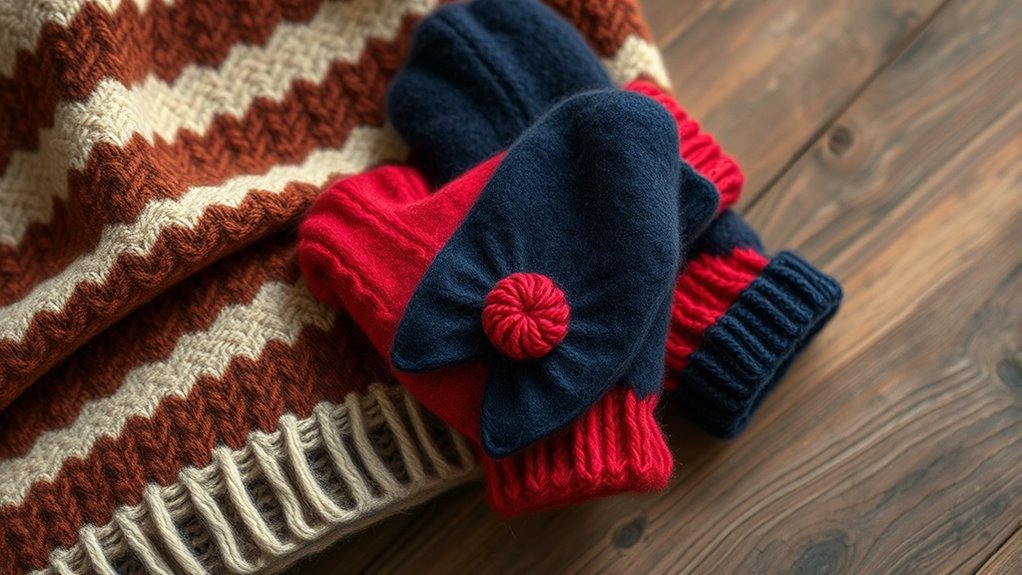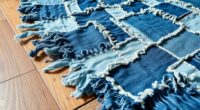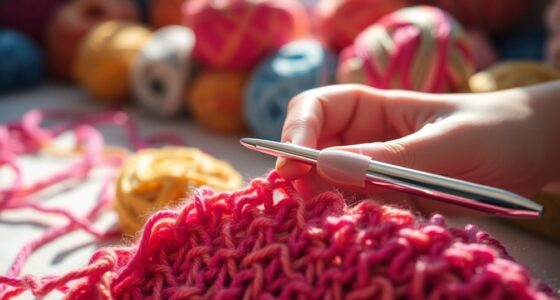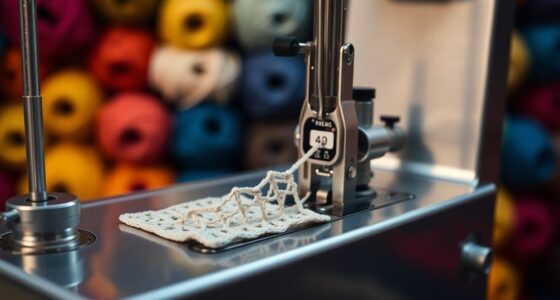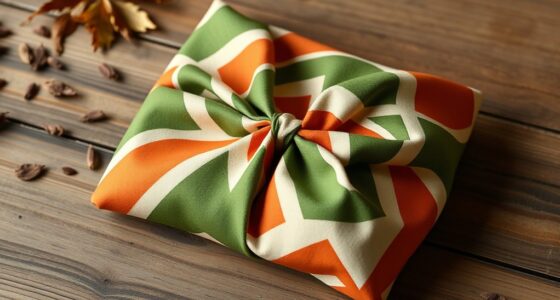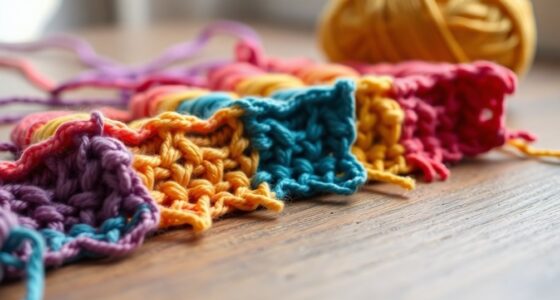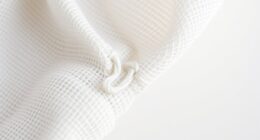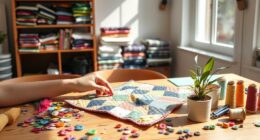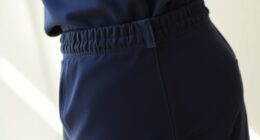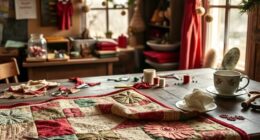To turn an old sweater into cozy mittens, start by selecting a 100% wool sweater and wash it in hot water to felt the fibers. Once felted, shape the fabric into mitten patterns, cutting out the pieces and assembling them with sturdy stitches. Add textures or embellishments if you’d like, and finish by sewing the pieces together. Curious to see how these simple steps come together? Keep exploring for all the tips and tricks to craft your perfect pair.
Key Takeaways
- Select 100% wool sweaters and wash in hot water to initiate felting.
- Dry on high heat to shrink and create dense felted fabric suitable for mittens.
- Cut felted wool into mitten shapes and assemble with sturdy sewing techniques.
- Add surface textures or embellishments like embroidery for visual interest.
- Use recycled, felted wool to craft cozy, eco-friendly mittens with unique character.
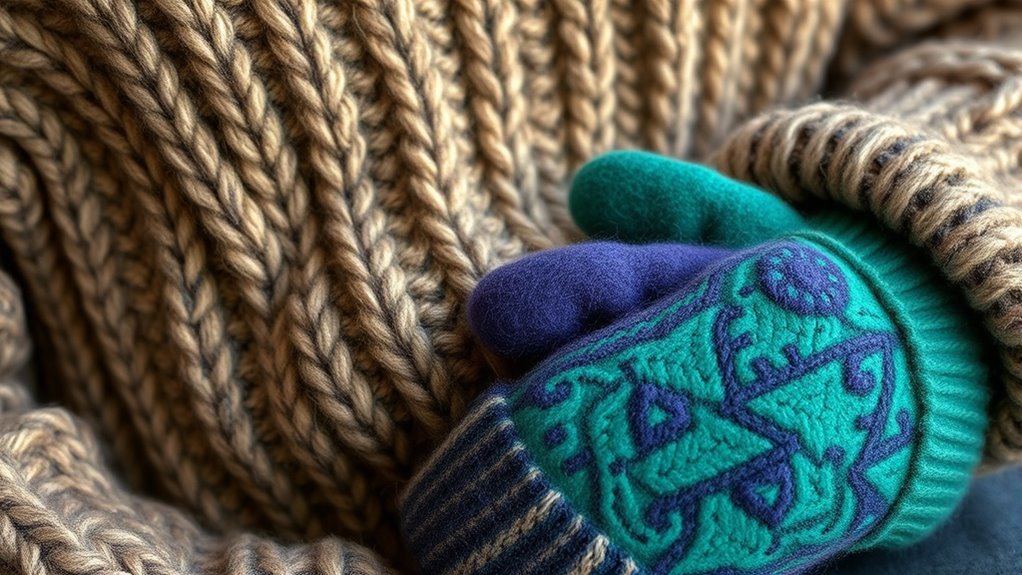
Have you ever wanted to create soft, durable felted wool objects? If so, you’re in the right place. One of the most satisfying ways to do this is by recycling old garments, especially wool sweaters, which are perfect for felting. Not only does this approach give new life to clothing you no longer wear, but it also helps reduce waste and environmental impact. Felting transforms these garments into dense, sturdy fabric that’s ideal for making cozy mittens, bags, or decorative items. Plus, working with recycled wool adds a layer of charm and uniqueness to your project, as each piece bears the textures and imperfections of its previous life.
Recycling old wool sweaters into felted objects adds charm, reduces waste, and creates durable, cozy handmade items.
To start, choose a wool sweater made of 100% wool—synthetic blends won’t felt properly. Wash the sweater in hot water with a bit of detergent, then dry it on high heat. This process causes the fibers to mats and tighten, transforming the garment into a dense, felted material. Once you’ve felted the sweater, you can cut it into the shapes needed for your project. The beauty of felted wool is its versatility; it can be easily shaped and sewn, making it ideal for creating textured surfaces that give your finished objects a rich, tactile quality.
As you work with felted wool, you’ll discover that creating textured surfaces adds visual interest and depth to your projects. You can do this by layering different pieces of felted fabric or by adding embellishments like embroidery, appliqué, or even small bits of other textured fibers. These techniques allow you to incorporate a variety of surface textures, giving your mittens or other items a handcrafted, artistic finish. If you want to add even more dimension, consider needle felting small details directly onto the surface, creating raised patterns or designs that pop out from the background fabric.
Throughout the process, keep in mind that felting is both an art and a science. The more you experiment with recycling old garments, the better you’ll understand how different fabrics respond to felting and how to manipulate textures for your desired effect. Remember, the key is patience—rushing can cause uneven felting or damage to your fabric. When you’re ready to assemble your project, use sturdy sewing techniques to piece everything together, and add extra felted details or decorative elements to enhance the textured surfaces. Additionally, understanding different wool types helps you select the best materials for your projects for optimal felting results. Before you know it, you’ll have a beautiful, functional item—like a pair of cozy mittens—that’s not only unique and stylish but also environmentally friendly.
Frequently Asked Questions
Can I Use Synthetic Wool for Felting?
You might wonder if synthetic wool works for felting. Typically, synthetic wool isn’t felting compatible because it lacks the natural fibers needed to bond during the felting process. If you try to felt synthetic wool, it probably won’t shrink or firm up like natural wool does. For successful felting, stick to natural fibers such as wool or alpaca, which are designed for this craft and will give you the best results.
How Do I Fix a Felting Mistake?
If you make a felting mistake, first prioritize felting safety by wearing gloves and working in a well-ventilated area. To fix it, gently re-wet the wool and carefully reshape or re-felt the affected area, ensuring you don’t cause further damage. Proper wool preparation helps prevent mistakes, but if they happen, patience and gentle handling are key to fixing your project without compromising its integrity.
What Tools Are Essential for Felting Wool?
To get started with felting wool, you’ll need essential tools like a felting needle, foam pad, and soap for fiber preparation. These tools help shape and tighten the fibers, making your project smoother. If you’re exploring dyeing techniques, choose appropriate dyes and follow proper methods to achieve vibrant colors. With these tools, you can confidently create and customize your felting projects, ensuring great results every time.
How Long Does the Felting Process Typically Take?
You wonder how long felting takes, and it varies based on your wool preparation and felting safety measures. Typically, the process can take from 30 minutes to several hours, depending on the thickness of the wool and your desired felted density. You need patience, consistent agitation, and attention to felting safety to guarantee even felting and prevent accidents. Keep checking your work to achieve the perfect felted result efficiently.
Can Felting Be Done With Hand or Machine?
You can definitely do felting with both hand felting and machine felting. Hand felting involves agitating or compressing wool by hand, which gives you more control over the process and results. Machine felting uses a washing machine or felting machine to speed things up, making it more efficient for larger projects. Choose hand felting for detailed work or smaller items, and machine felting when you want faster, uniform results.
Conclusion
Now that you’ve transformed an old sweater into cozy mittens, you’ve woven a little magic from forgotten fibers. Your hands have turned scraps into warmth, like a phoenix rising from the ashes of old fabric. Each stitch and felting motion has stitched together more than just wool — it’s stitched together creativity and sustainability. So, wear your new mittens proudly, knowing you’ve crafted not just warmth, but a story of renewal spun from the heart of your own hands.
